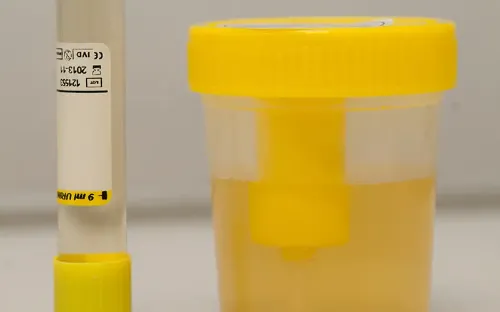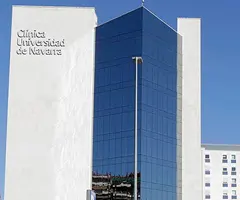Diabetic nephropathy
"If you have diabetes, protecting your kidneys starts today: control glucose and blood pressure, and have regular check-ups. Detecting it early changes the prognosis."
DR. JAVIER ESCALADA
DIRECTOR. ENDOCRINOLOGY AND NUTRITION DEPARTMENT

What is diabetic kidney disease or diabetic nephropathy?
Diabetic kidney disease (DKD)—also called diabetic nephropathy when confirmed by kidney biopsy—is a progressive damage to the kidneys caused by diabetes and worsened by high blood pressure. It often causes no symptoms at first, which is why regular check-ups are important.
DKD is considered present when there is protein in the urine (albumin-to-creatinine ratio ≥ 30 mg/g) or when kidney function is reduced (eGFR < 60 mL/min/1.73 m²) for more than 3 months.
Approximately 40–50% of people with type 2 diabetes (T2D) will develop chronic kidney disease (CKD). This matters because the combination of diabetes and CKD increases cardiovascular mortality by about 50% (heart attack, arrhythmias, heart failure), so heart care is part of the treatment plan.
To slow progression, it is essential to keep blood glucose and blood pressure well controlled, follow the screening schedule your specialist recommends (urine and blood tests), and—in type 2 diabetes—consider kidney-protective treatments such as SGLT2 inhibitors, always under medical supervision.

What are the symptoms of diabetic kidney disease?
Diabetic kidney disease often progresses silently: symptoms appear gradually and, frequently, in later stages when the damage is already significant.
In the early stages, the only sign may be nocturia (getting up to urinate several times at night). As kidney function worsens and waste products build up in the blood, general discomfort and more noticeable signs begin to appear.
Signs in this advanced stage reflect this toxin buildup, including fatigue and general weakness, nausea, loss of appetite (anorexia), and, often, swelling in the legs and ankles. You may also experience intense itching (pruritus) or trouble sleeping and concentrating.
Symptoms to watch for include:
- Fatigue and general weakness (often related to anemia).
- Swelling (edema) in the feet and ankles due to fluid retention.
- Nocturia: needing to urinate several times during the night.
- Loss of appetite (anorexia), nausea, and vomiting due to buildup of metabolic waste.
- Skin itching (pruritus).
- Muscle cramps and spasms.
- Sleepiness, trouble concentrating, or confusion (possible uremic encephalopathy).
Are you diagnosed with diabetes?
Remember that it is important to regularly monitor your kidney function
What are the causes of diabetic kidney disease?
The main cause of diabetic kidney disease is persistent hyperglycemia: high glucose levels damage the kidney’s small blood vessels and filters (glomeruli). Diabetes mellitus is, in fact, the leading cause of chronic kidney disease (CKD).
It is often associated with high blood pressure, which adds extra “force” on the renal vessels and accelerates the decline in function. In addition to direct vascular injury, CKD involves local and systemic inflammation that drives its progression.
The loss of nephrons forces the remaining ones to work harder, which sustains inflammation and damage. This inflammatory state is key to accelerating kidney deterioration.
What is the prognosis of this disease?
Prognosis depends mainly on two factors: the level of kidney function (estimated glomerular filtration rate, eGFR/FGe) and the level and persistence of albuminuria (protein in the urine). The lower the eGFR and the higher the albuminuria, the greater the renal and cardiovascular risk; in fact, with eGFR < 60 mL/min/1.73 m² the cardiovascular risk is very high.
Without treatment, chronic nephropathy can be fatal and, in advanced stages, cardiac, vascular, or infectious complications are common. The better blood glucose and blood pressure are controlled, the more slowly kidney function tends to decline. Early, intensive management (strict glycemic and blood-pressure control, treatment of dyslipidemia, smoking cessation, exercise, and an appropriate diet) aims to slow progression.
If the disease still progresses to end-stage kidney failure (stage 5), the options are renal replacement therapy (dialysis) or, ideally, a kidney transplant, which offers the best survival and quality of life.
How is diabetic nephropathy diagnosed?

Diabetic kidney disease is often silent at the beginning, so early diagnosis is key. It rests on two pillars:
- Kidney function (eGFR): blood test with creatinine; eGFR < 60 mL/min/1.73 m² maintained for ≥ 3 months indicates CKD.
- Glomerular filter damage (albuminuria): albumin-to-creatinine ratio (ACR) in the first morning urine; confirm with 2 elevated results out of 3 samples (over 3–6 months).
Additional tests may be needed, such as a renal ultrasound to assess size/obstructions and, in selected cases, a kidney biopsy.
If you have diabetes, get screened with eGFR and ACR at least once a year. Detecting it early helps slow progression.
How is diabetic kidney disease treated?
The current approach is multifactorial and combines glycemic control, general support measures and new therapies of the last decade that have been a revolution due to the significant renal and cardiovascular benefits demonstrated.
Lifestyle
A healthy lifestyle is the basis for preventing and slowing the progression of diabetic kidney disease. It should be tailored to your clinical situation and physical capacity.
- Physical activity and weight: Avoid tobacco entirely (smoking accelerates kidney damage). Do moderate physical activity for at least 150 min/week (or as tolerated) and reduce sedentary time. If you have overweight or obesity, weight loss helps protect both kidneys and heart.
- Diet: Follow a healthy, varied eating pattern with a higher proportion of plant-based foods and fewer ultra-processed foods. Work with a renal dietitian to adjust sodium, potassium, phosphorus, and protein to your individual needs.
- Sodium intake: Limit sodium to < 2 g/day (equivalent to < 5 g/day of salt). This helps prevent fluid retention, supports blood pressure control, and enhances the effect of kidney-protective medications.
Glycemic control
Because diabetes is one of the most common causes of CKD, keeping blood sugar well controlled helps slow kidney damage. The plan should be individualized with your specialist.
- Target (HbA1c): for shorter-duration diabetes and good life expectancy, a common goal is HbA1c < 7%. For long-standing diabetes, frailty, or high risk of severe hypoglycemia, the goal should be individualized.
- Key medications in T2D + CKD:
· SGLT2 inhibitors (SGLT2i): recommended when eGFR ≥ 20 mL/min/1.73 m² (cardiorenal protective effect).
· Metformin: consider if eGFR ≥ 30, with dose adjustment by kidney function.
· Long-acting GLP-1 receptor agonists: if targets are not met despite metformin and SGLT2i, prioritizing agents with proven cardiovascular benefit. - Avoid hypoglycemia: review doses (especially insulin and sulfonylureas) and consider glucose monitoring. Check HbA1c every 3–6 months and pursue therapeutic education.
Blood pressure control (hypertension)
Hypertension is a key driver of CKD progression. Treatment aims to: lower blood pressure, reduce cardiovascular risk, and slow disease progression.
- BP target: in adults with elevated BP and CKD, a systolic BP < 120 mmHg is suggested when tolerated.
- If moderate to severe albuminuria is present (ACR ≥ 300 mg/g), aim for values closer to 130/80 mmHg.
- First-line medications (RAAS blockade): ACE inhibitors (ACEi) or angiotensin II receptor blockers (ARBs). Recommended in CKD with moderate–severe albuminuria, with or without diabetes; they can reduce the rate of kidney function decline.
Cholesterol control (dyslipidemia)
Dyslipidemia accelerates the decline in kidney function and increases cardiovascular risk. In CKD with eGFR < 60 mL/min/1.73 m², patients are considered at very high risk, so management should be proactive.
- Pharmacologic treatment: in adults ≥ 50 years with eGFR < 60 (stages G3a–G5) not on dialysis and without a transplant, statins or statin/ezetimibe are recommended to reduce cardiovascular events.
- Therapeutic approach: guidelines (KDIGO) prioritize statin-based therapy according to overall risk rather than pursuing a strict LDL cholesterol target.
- Diet: adopt a plant-forward Mediterranean-style pattern; limit total calories from fat to ≤ 30%, saturated fat to ≤ 10%, and dietary cholesterol to ≤ 300 mg/day. Reduce ultra-processed foods and added sugars.
Pharmacologic treatment
- ACE inhibitors or ARBs (RAAS blockade): first line when albuminuria is present; use the maximum tolerated dose. Monitor creatinine and potassium.
- SGLT2i (e.g., empagliflozin/dapagliflozin): add if no contraindications (generally with eGFR ≥ 20). Cardiorenal benefit.
- GLP-1 receptor agonists (long-acting): reduce albuminuria, slow eGFR decline, and provide cardiovascular benefit. Consider if targets aren’t met despite metformin + SGLT2i.
- Finerenone (nonsteroidal mineralocorticoid receptor antagonist): for persistent albuminuria despite ACEi/ARB (± SGLT2i).
Where do we treat it?
IN NAVARRA AND MADRID
The Nephrology Service
of the Clínica Universidad de Navarra
The Nephrology Service of the Clínica Universidad de Navarra has more than five decades of experience, both in the diagnosis and treatment of all kidney pathologies and in the transplant of this organ.
Our specialists have completed their training in centers of national and international reference.
We have the best facilities in the Dialysis Unit in order to offer the highest quality care to our patients.

Why at the Clinica?
- National reference in kidney transplantation, pioneer in living donor kidney transplantation.
- Specialized nursing for the care and follow-up of our patients.
- Cardiovascular and renal damage prevention program.









